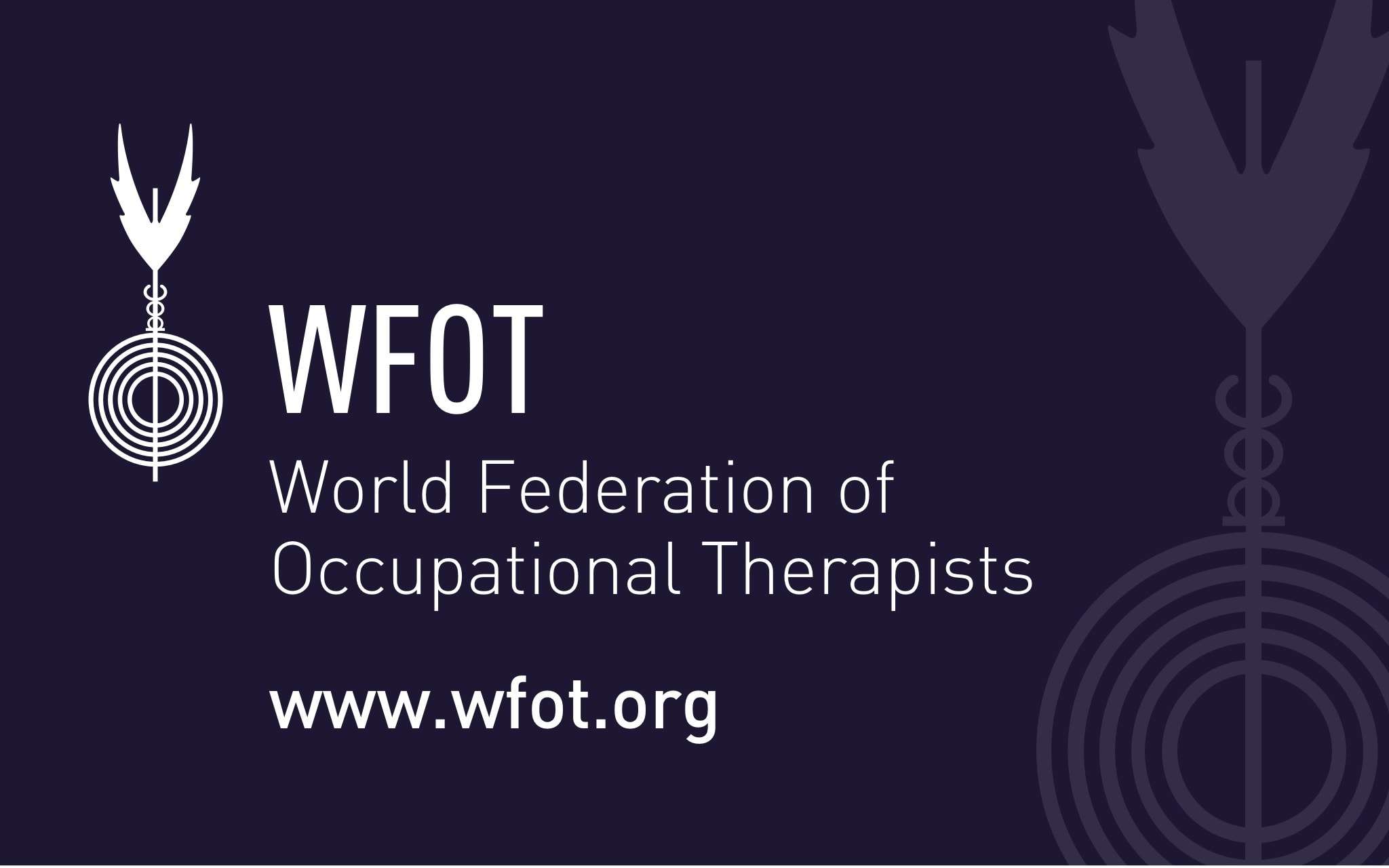Occupational Therapy (OT) is a health profession recognized by law (Law 44/2003 of 21 November on the Regulation of Health Professions); entry to occupational therapy practice requires specific university-level education. Occupational therapists, as members of transdisciplinary teams working in health and social settings,have direct contact with people with different types of disabilities, different levels of dependency or functional limitations, and/or with people who are restricted in their social participation; therefore, the implementation of OT interventions has a direct effect on the health, personal autonomy, and quality of life of people.
Occupational therapy occupies a privileged position in the rehabilitation process: when addressing activities of daily living (ADLs), it is necessary to coordinate physical, cognitive, emotional, and behavioral aspects to achieve the patient’shighest level of function(1).
Occupational therapy is regulated by different laws and regulations. Article 7 of the Law on the Regulation of Health Professions defines the role of occupational therapists as follows: “Occupational therapists are university graduates in occupational therapy responsible for implementing techniques and carrying out activities of an occupational nature to enhance or compensate for diminished or lost physical or cognitive functions, and to guide and increase development of such functions”(2). If, on the other hand,we take the consensus definitions across the European environment such as those of the ENOTHE terminology group(3), the term “occupation” is defined as such: “A group of activities that has personal and socio-cultural meaning, is named within a culture and supports participation in society. Occupation can be categorised as self-care, productivity and/or leisure.” For an activity to be understood as therapeutic, it must have a series of characteristics, including the following:
Characteristics
- Be goal-directed
- Be meaningful to the client
- Be a suitable tool for the prevention of dysfunction, maintenance or improvement of function, skill, and quality of life
- Promote client participation in activities of daily living
- Be determined by the occupational therapist professional judgment based on knowledge of the pathology, specific procedures, interpersonal relationships, and the specific value of such activity.
In view of the above aspects, occupational therapy can be defined as a set of techniques, methods and procedures to—through activities used for therapeutic purposes—prevent disability and maintain health, promote restoration of function, compensate for deficits and assess behavioral responses and their importance for achievingtheindividual’s maximum level of independencein activities of daily living, both basic and instrumental, and the possible reintegration of the individual in each of several dimensions:physical, psychological, cognitive, emotional, social, and career.
On the other hand, in 1968, the American Occupational Therapy Association (AOTA)defined occupational therapy as such (4): “The art and science of directing man’s response to selected activity to promote and maintain health, to prevent disability, to assess behavior, and to treat or train patients with physical or psychosocial dysfunctions.”
Goals and functions of occupational therapy
Thegeneric goals pursued in the practice of occupational therapy are: disability prevention, health promotion (COTEC, 2012) and the achievement of an optimallevel of functioning in those individuals whose function is reduced or impaired by injury, physicalor mental illness, dysfunctional condition, developmental or learning disabilities or adverse contextual factors.
Occupational therapy includes four major concepts (5) that define it as a profession and define the overall goals of its intervention:
- Occupational therapy is a health-related profession using selected activity to prevent and overcome many physical, emotional or social disabilities in people of all ages. The objective is to promote, maintain and/or restore functional independence in daily living skills.
- Occupational therapy is concerned with human occupation and its importance in health for persons of all ages. Occupational therapists evaluate the physical, psychosocial and environmental factors which reduce a person’s ability to participate in everyday activities of occupation.
- Therapeutic objectives are achieved through techniques or activities designed to:
- Diminish and control pathology
- Restore and/or reinforce functional capacity
- Facilitate learning of skills and function essential for adaptation to the environment
- Promote and maintain health
- Occupational therapy is a health profession which teaches,maintains, and promotes competent behaviourin the areas of daily living, learning and working to individuals experiencing illness, developmental deficits and/or physical and psychological dysfunction or who are otherwise at risk.
Promotion of health and well-bein
Occupational therapy is a profession based on the promotion of health and well-being through occupation, which is its core concept, and whose primary goal is to enable people to participate in activities of daily living. To this end, occupational therapists have a broad education in the skills, abilities and capacities of humans related to their participation in a variety of activities and contexts, as well as inthe interactions that occur between these elements in people with limitations or impaired body structures, which hindertheir participation in the occupations of everyday life.
On the basis of the above, the roles of occupational therapists in the departments of physical medicine and rehabilitation include: re-education and training in the basic and instrumental activities of daily living;development, remediation, or compensation of cognitive, perceptual, neuromuscular, sensory-motor functions and behavioral skills, among others;the design, fabrication and training in assistive technology (adaptation and training in positioning devices and wheelchairs, for example); the evaluation, consultation, and application of ergonomic principles, and adaptation to physical and sensory environments (e.g.: architectural barriers, adaptation to the workplace environment, etc.).
Disability prevention
Occupational therapists provide services in disability prevention, activity limitation, and participation restriction. The primary goal of occupational therapy is to enable peopleto participate in the activities of everyday life (6). More specifically, the goals or aims of occupational therapy are:
- Disability prevention: occupational therapists help clients avoid problems in activities of daily living, prevent occupational dysfunctions, prevent future injuries or diseases in occupational performance, and participate in projects and actions aimed at the prevention of disability at the community level.
- Evaluation of performance components of activities of daily living from a specific and global perspective: occupational therapists perform functional assessments of both joint range of motion and muscle strength, assess functional limitations, analyze everyday gestures, evaluate sensory, perceptual, cognitive and behavioral capacities related to activities of daily living,assess social skills,and evaluatehome and work environments.
- Maintenance, acquisition, improvement or restoration of the components of activities of daily living: improving mobility,strength, coordination, and dexterity;increasingpain threshold andpain tolerance; teaching compensation techniques for lost or impaired functions, range-of-motion exercises and energy conservation techniques; developing functional residual capacity; evaluating residual functional capacity; fabricating, fitting and training in the use of prosthetic and orthotic devices; improvingadherence to medical treatment;helpingclientsenvision their possibilities for improvement and achievement offunctional independence;working to maximize independence in activities of daily living;fabricating and training in assistive technology for both basic and instrumental activities of daily living, including the use of mobility devices such as wheelchairs, walkers, etc.; modifying/adapting the work environment; eliminating/adapting architectural barriers; helping clientslive with theirlimitations by providing a realistic and optimistic vision of their new situation, as well as recommending and informing them about interests and occupations.
In short, occupational therapists assist disabled clients to maximize their functional capacities, develop functional residual capacities, compensate for their functional deficits, and achieve their reintegration into the community while achieving the greatest possible degree of independence.
Bibliography
1.- Sánchez Cabeza, A. ¿Qué es un terapeuta ocupacional neurológico y en qué puede ayudarle? In: Guía de Neuroterapia Ocupacional. Ediciones SEN. Madrid. 2016.
2.- Boletín Oficial del Estado. 21340 Ley 44/2003, de 21 de noviembre, de ordenación de las profesiones sanitarias;2003.
3.- European Network Occupational Therapy in Higher Education. European Occupational Therapy Terminology Database. (citado 7 de septiembre de 2009). Available: http://pedit.hio.no/-brian/enothe/terminolgy/
4.- American Occupational Therapy Association: Summary report: 1990 member data survey, Rockville MD, AOTA, 1990.
5.- World Federation of Occupational Therapy. Definitions of occupational therapy, draft 7. August 2005.
6.- Summary of the occupational therapy profession in Europe 2012. Council of Occupational Therapists for the European Countries (COTEC). Update 06/06/2012. Available: www.baot.org.uk.
But, what does an occupational therapist actually do? Here’s a look at the roles and responsibilities of occupational therapists, as well as the required skills and education, and career outlook.
What is an Occupational Therapist?
Occupational therapy (OT) is an allied health profession that involves the therapeutic use of everyday activities, or occupations, to treat the physical, mental, developmental, and emotional ailments that impact a patient’s ability to perform day-to-day tasks.
As such, an occupational therapist is a practitioner who uses therapeutic techniques to improve, rehabilitate, or maintain a patient’s ability to perform everyday activities.
Michael Roberts, associate professor and program director for the master’s in occupational therapy program at Regis College, explains, “Our job as OTs is to help people be more independent, have better quality of life, and live with as few restrictions as possible.”
Occupational therapy differs from other healthcare professions like physical therapy or nursing in its focus on treating the whole patient, rather than treating a particular injury, ailment, or disability. For example, after a surgery a nurse might assist a patient with pain management, dressing changes, and care during recovery. An occupational therapist, on the other hand, will assess the activities that are important to the patient and teach them how to become independent again following the surgery, so that they can resume the roles that define who they are.
“What sets OTs apart is our focus on occupation as the tool we use to restore, rebuild, and enhance our clients’ lives,” notes Roberts. “When we say ‘occupation’, we mean the activities that we do every day; the roles, tasks, and goals that define who we are. Everyone has activities that define who they are, whether it’s work tasks, artistic expressions, leisure pursuits, school responsibilities, or play activities. Using those activities as therapeutic tools helps us build better lives for our patients.”
Key Roles and Responsibilities
As discussed above, occupational therapists work with their patients by taking a therapeutic approach to everyday activities. Broadly, this means that occupational therapists are responsible for helping patients develop, recover, improve in regards to a condition or injury, as well as maintain the skills needed to execute daily activities. But, what does this actually entail?
In general, OTs are responsible for a wide range of duties and tasks related to patient care. Depending on the setting in which they work, the roles of an OT often include:
- Evaluating a patient’s condition and needs
- Developing treatment plans to address a patient’s needs and help them meet specific goals
- Assessing a patient’s home and/or work environment and recommending adaptations to fit the patient’s needs and improve independence
- Training patients and their caregivers to use special equipment
- Assess and document progress for evaluation, billing, and reporting purposes
- And more
The day-to-day activities that occupational therapists take part in will also likely be influenced by the settings in which they work. Many occupational therapists work in hospital or private practice settings, however, there are many opportunities to work in other environments. For example, some practitioners work in educational settings to assist in child development or with the elderly to lessen the struggles that come along with aging. Those with an entrepreneurial spirit may even choose to open and manage their own private practice.
Required Skills
While occupational therapists come from all backgrounds, there are several key skills and qualities that lend themselves well to the nature of occupational therapy work. For instance, it is important for these professionals to have a strong sense of compassion and empathy in order to work with their patients’ best interests in mind. In fact, many occupational therapists are drawn to this line of work from a desire to make a positive difference in the lives of others.
In addition to having a people-oriented mindset, there are several skills that OTs should have to be successful in the field. Among these include:
- Communication skills: OTs must have strong written and verbal communication skills in order to effectively understand the needs of their patients and explain the treatment process. Additionally, they must be able to clearly document treatment plans and progress, as well as collaborate with other healthcare professionals.
- Problem Solving: Since no two cases will ever be the same, good OTs must demonstrate excellent problem solving skills to determine the best course of action for each unique situation.
- Patience and Flexibility: Often times, occupational therapy is a long road to restoring a patient’s independence. Good OTs must be patient and flexible when dealing with the high and low points throughout this process.
Required Education
Like many healthcare professions, occupational therapy requires extensive education and training in order to become a licensed practitioner. Most OTs enter the workforce with at least a master’s degree in occupational therapy, while some also choose to pursue a doctoral degree to advance further in the field.
In addition to earning a master’s degree from an accredited program, graduates must also take the national exam administered by the National Board for Certification in Occupational Therapy (NBCOT). While the requirements vary by location, all states require practitioners to pass the NBCOT exam to earn the title “Occupational Therapist, Registered” (OTR) and obtain state licensure.
For occupational therapists who wish to demonstrate their advanced skills in a particular area of practice, the American Occupational Therapy Association (AOTA) also offers various board and specialty certifications in areas such as:
- Gerontology
- Mental Health
- Pediatrics
- Physical Rehabilitation
- Driving and Community Mobility
- Environmental Modification
- Feeding, Eating, and Swallowing
- Low Vision
- School Systems
Career Outlook
Occupational therapists and those looking to enter the field can expect generous compensation and job growth over the coming years.
According to the Bureau of Labor Statistics (BLS), employment for OTs is expected to grow by 18 percent from 2018 to 2028, much faster than the average for all occupations. This change equates to roughly 23,700 more jobs in the field through the next decade.
In 2018, the BLS also found that occupational therapists earned an average annual salary of $84,270. Of course, compensation can vary substantially depending on the state in which they are employed.
The need for occupational therapists is predicted to rise in order to care for the aging baby-boom generation, as OTs play a large role in the treatment of age related ailments like arthritis and stroke. Furthermore, as patients continue to seek long-term treatment for disabilities and chronic illnesses, the demand for skilled and compassionate practitioners will continue to grow.
Becoming an Occupational Therapist
Occupational therapy is highly rewarding rewarding work that is growing in demand as the healthcare landscape continues to evolve. For those considering a career in the medical field, but are unsure of the direction they should follow, occupational therapy can be a valuable opportunity.
Roberts explains, “The biggest difference between OT and many other health care professions is that ‘We do with people, not to people.’ We’re all about helping people live life to the fullest, regardless of what their life is like or who they are.”
If you are passionate about making a positive impact in the lives of others, occupational therapy might be the right path for you. To get started on this path, earning a master’s in occupational therapy is the first step in becoming a registered OT and making a difference.
Are you considering earning your master’s degree in occupational therapy and becoming an occupational therapist? Learn more about the different reasons it might be the right move for you.




